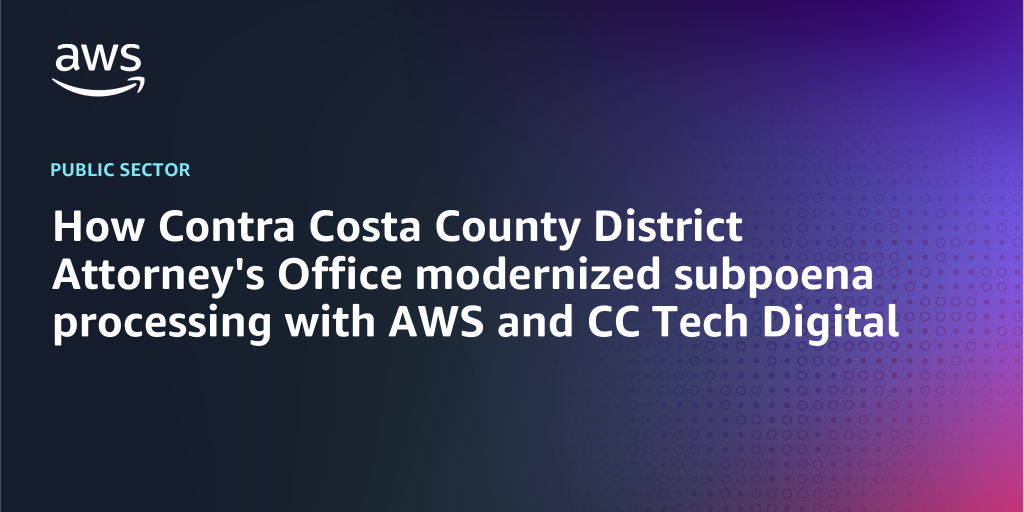AWS Public Sector Blog
Tag: serverless
How Contra Costa County District Attorney’s Office modernized subpoena processing with AWS and CC Tech Digital
The Contra Costa County District Attorney’s Office partnered with AWS and CC Tech Digital, an AWS Advanced Tier Partner, to modernize its subpoena handling process using a cloud-native, serverless solution on AWS. Read this post to learn more.
Efficient large-scale serverless data processing for slow downstream systems
This post demonstrates how to build serverless workflows on AWS that process such data using AWS Step Functions and integrate with downstream systems that have concurrency limitations.
How the Republic of Singapore’s Air Force has redefined airspace management
In this blog post, we’ll share how the Republic of Singapore’s Air Force, with the support of AWS, responded to a specific challenge: how to operate unmanned aerial vehicles (UAVs or drones) in a crowded, complex airspace.
Near real-time dashboards from a source database to a cloud data warehouse on AWS
Organizations require solutions for real time or near real time dashboards that can be provided to their customers without impacting their database performance or service level agreements (SLAs) to their end users. In this post, we showcase the integration of Amazon Web Services (AWS) capabilities to present an end-to-end architecture for this data flow.
Data dissemination for public sector on AWS
Sharing data is essential for organizations to make informed decisions and foster innovation. Amazon Web Services (AWS) offers a variety of tools and services to help distribute data securely and at scale. Whether it’s sharing public data for the common good, monetizing private datasets for business purposes, or collaborating with colleagues, AWS provides the necessary infrastructure and support. Read this post to learn more.
Frugal architecture in action: The Urban Institute innovates with R and Serverless on AWS
Nonprofit organizations are typically frugal and responsible. They strive to improve the human condition in innumerable ways, yet they cannot raise capital like a commercial organization, so they have to make the most of the resources they have. They apply that frugal approach to IT: they build and operate only what they need to pursue their mission, and constantly innovate both to meet mission objectives and optimize cost. Even with these constraints, nonprofits aspire to solve some of the world’s biggest problems, and often, they use innovative IT architectures on Amazon Web Services (AWS) to do it.
Concerts for Carers uses AWS Fargate, Amazon Aurora to deliver ticketing and events platform at any scale
In April 2020, during the COVID-19 pandemic, while frontline workers were under immense pressure, three experienced live event professionals wanted to thank all of the UK’s National Health Service (NHS) workers and paid care workers. They combined their extensive experience and knowledge to launch the not-for-profit charity Concerts for Carers, whose mission is to promote the mental health and well-being of all NHS workers and paid caregivers and to provide them with free tickets to live events in the UK as an ongoing gesture of thanks. This post highlights how they’ve used Amazon Web Services to meet their mission.
Satellite mission operations using artificial intelligence on AWS
Cognitive Space is a leading Amazon Web Services (AWS) Partner delivering intelligent automation to satellite constellation operations using the CNTIENT platform. The system uses AWS-powered artificial intelligence (AI) decision making to handle highly complex and dynamic satellite tasking requirements, and demanding mission requirements. This blog post provides technical guidance for building and operating mission operation centers (MOCs) on AWS.
Building the WIS 2.0 global weather cache on AWS
The World Meteorological Organization (WMO) wants to build and modernize a global weather framework with WMO Information Systems (WIS) 2.0 to enable and democratize unified access to critical, up-to-date weather data across the world. The WIS 2.0 system and the global cache provide a single point of access to improve the speed and accuracy with which forecasts can be generated while decreasing the time and capital requirements. This post describes the value of a global weather cache as well as the design and architecture for building the WIS 2.0 global weather cache on Amazon Web Services (AWS).
Use modular architecture for flexible and extensible RAG-based generative AI solutions
In this post, we cover an Amazon Web Services (AWS) Cloud infrastructure with a modular architecture that enables you to explore and take advantage of the benefits from different Retrieval-Augmented Generation (RAG)-based generative AI resources in a flexible way. This solution provides several benefits, along with faster time-to-market and shorter development cycles.









